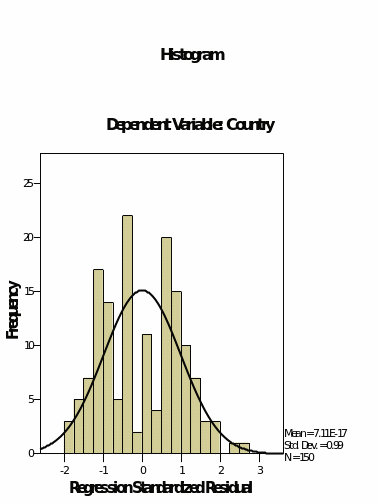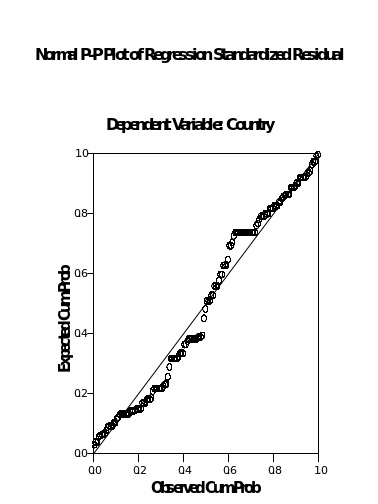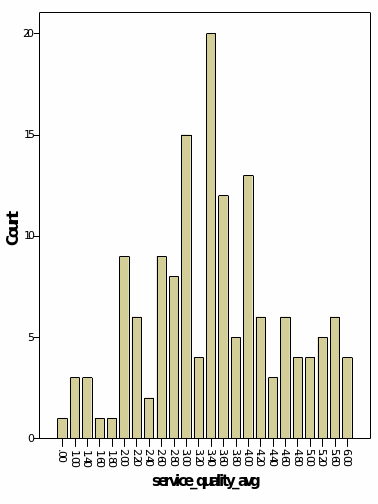Regression studies

The above diagram shows the regression analysis on the components of the theory of planned behavior in the two countries. The analysis shows that the data is normally distributed with a mean of 8.15E-17 and a 0.99 standard deviation. The implication of the above graph is that the influences of an individual’s behavior are at their peak in the middle of the value rating. This is typical data showing that there are fewer individuals that are certain of purchasing the commodity due to the factors of planned behavior. This is also similar to those who are not sure of making that decision (Stocking & Lord 1983, p.201).

Figure 2 above is a linear distribution of the effects of the components of TPB in the two countries. It is clear from the above distribution; the data follows the regression model as shown by the line of best fit. At the beginning of the curve is the data for the distribution in the United Kingdom while towards the end is the data distribution of Germany (McCullough 1999, p.633).
Effect of merchandise quality and Service quality on TPB

The above graph shows the effects of the merchandise quality on the TPB model. It can be clearly seen from the diagram that the effects of merchandise display a normal curve. At a level four of the rating is where there is the highest influence while it is the lowest at the peripheries (Stills 1989).

The impact of service quality on the TPB is shown in figure 4. The curve shows that the distribution is also on a normal curve where the highest influence is in the middle and reduces towards the two ends. This, however, is not as smooth as the effects of the merchandise on the TPB (Haebara 1980, p.144).
Discussion
The theory of planned behavior is one of the best models, which can be used to gauge an individual’s actions depending on their response to a number of factors. The innate factors are the core influential features that dictate the behavioral actions of individuals. This is seen by the effects of the intention, one of the components of TBP, of the individuals surveyed on the decision of buying a given commodity. Indeed it is evident from the model in figure 1 that it has direct effects on the final behavior of the individual (Koger & Winter 2010).
The perceived aspects of controlling behavior have a direct effect on both the final behavior and the intentions of the person in question. From the results above it is evident that a person’s behavior is dependent on the manner in which the individual perceives themselves. The attitude and the subjective norm have a direct influence on the attitude of the individuals which in turn affect the overall behavior (Stern 2005, p.10785).
The components of TPB are not the only factors that affect the behavior of a person, owing to the fact that there are other considerations, which have an influence on the final behavior. The merchandise and the service quality are the other factors that are not in the TPB model yet they have an influence on the individual’s behavior towards the purchase of the commodity (Kim & Kolen 2007, p. 371). Generally, most of the factors have a moderate influence on the behavior of the individuals, and that is why a larger number of the members on a scale of 1 to 6 lies between 3 and 5 in their response to the TPB factors as far as their behaviors are concerned (Sheppard 1996, p.49).
The effects of merchandise quality and service quality though not directly on the behavior of the individual have been studied. The results, it shows that the influence at each level of the TPB features along the measurement scale is significant (Sternberg 1990).
Indeed a behavior is not a discrete component that can be definitely determined, and therefore, it can only be approximated by considering all the factors both innate and the external factors which surround the individual. The factors shown on the graphs show normal distribution, which is the most common distribution as far as human performance is concerned and therefore, can be adopted as typical results. Moreover, the results from the behavioral changes in both Germany and United Kingdom show great similarities, and thus they can be generalized to other parts of the world (Gorsuch1983).
Conclusion
The manifestation of the response of an individual observed in relation to given target results in behavior. The observations can be made over a span of time and extended to cover a number of contexts in order to give a generality of the behavior by giving some tangible comparisons and trends. The theory of planned behavior is one of the theories, which relates to the way in which individuals perceive themselves and the compatibility of their intentions as well as the control facets of behavior. In a nutshell, the perceived behavioral control is a moderating feature to the behavioral intentions which in turn yield to a given behavior depending on the strength of the intentions of the individual. From the above study, it can be concluded that the TBP model has been clearly portrayed by the results gathered and the graphical representations. Practically, the intentions and the perceptions of the individuals in the society directly influence the behavior of a person however the two factors do not interact with each other at all in a significant manner (Sniehotta 2009, p. 257).
The study above has yielded a result which clearly supports the theory, and therefore, it can be used by the individuals who are in marketing to capture and estimate the behavior of a population and in the process use it as a marketing tool to influence their behavior. The marketing of ALDI is more predictable after the study and a pilot survey can be done before the introduction of a new commodity in the market. It is from such a study that, the individual’s behavior towards the purchase of the commodity has been ascertained. It is from the results that manipulation of the behavior can be done and thus resulting in a very powerful marketing tool (McCullough 1999, p.191).
References
Gorsuch, R., 1983. Factor Analysis. Hillsdale, NJ: Lawrence Erlbaum.
Haebara, T., 1980. Equating logistic ability scales by a weighted least squares method. Japanese Psychological Research, 22 (3), pp.144-149.
Kim, S., and Kolen, M.J., 2007. Effects on scale linking of different definitions of criterion functions for the IRT characteristic curve methods. Journal of Educational and Behavioral Statistics, 32 (4), pp.371-397.
Koger, S. and Winter, D., 2010. The Psychology of Environmental Problems. New York: Psychology Press.
McCullough, B.D., 1999. Econometric software reliability: EViews, LIMDEP, SHAZAM and TSP. Journal of Applied Econometrics, 14 (2), pp.191–202.
Sheppard, A.G., 1996. The sequence of factor analysis and cluster analysis: Differences in segmentation and dimensionality through the use of raw and factor scores. Tourism Analysis, 1 (1), pp.49-57.
Sniehotta, F.F., 2009. An experimental test of the Theory of Planned Behavior: Applied Psychology. Health and Well-Being, 1 (2), pp.257-270.
Stern, P.C., 2005. Understanding individuals’ environmentally significant behavior, Environmental Law Reporter. News and Analysis, 35 (11), pp.10785-10790.
Sternberg, R.J., 1990. The geographic metaphor. New York: Cambridge.
Stills, D., 1989. International encyclopedia of the social sciences: Biographical supplement (Vol. 18). New York: Macmillan.
Stocking, M.L. and Lord, F.M., 1983. Developing a common metric in item response t heory. Applied Psychological Measurement, 7 (2), pp.201-210.